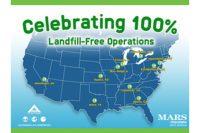Every year, an estimated 1.3 billion tons of solid waste is collected globally, according to the World Bank, Washington, D.C., and this total is expected to top over 2.2 billion by 2025. Decomposing solid waste from landfills not only has the potential to leak harmful chemicals into the ground water, but it also contributes a staggering 3-5% of global greenhouse gases.
At Unilever North America, Englewood Cliffs, N.J., environmental sustainability is a core element of our business strategy. In fact, by 2030, our goal is to halve the environmental footprint of the making and use of our products as we grow our business.
The Unilever Sustainable Living Plan is the blueprint for achieving our vision to grow our business, while decoupling the environmental footprint from our growth. In 2012, we committed to achieving zero-waste-to-landfill (ZWTLF) for non-hazardous waste across our global manufacturing network by 2020. The waste reduction strategy embedded within this goal will help Unilever mitigate our operational and supply chain risk by addressing resource scarcity or potential surges in raw material prices. Rather than considering these issues as challenges, Unilever views these business opportunities as value drivers that support more effective materials management processes and lower waste management costs.
Inherently, Unilever maintains a strong track record of designing out waste from factories, so when zero waste to landfill was added as a USLP target, the company focused on embedding a “zero waste mind-set” to rapidly accelerate the speed of the global rollout program, increase resource resilience and reach the USLP target well ahead of schedule. Manufacturing sites across the world started delving into their waste streams—a figurative ‘‘dumpster dive’’—to identify sustainable solutions for all waste products. In addition, cross-functional teams with members from various organizations, including safety, health and environment (SHE), procurement, finance, legal and operations started collaborating under a common purpose.
To achieve zero-waste-to-landfill, Unilever adopted the four ‘R’ approach – first, reducing waste at source, then re-using, recovering or recycling any non-hazardous waste that remains. In conjunction with this approach, Unilever formed partnerships with waste management companies that helped identify recycling and re-use outlets. Teams quickly realized that their waste streams could generate significant recycling revenues if properly handled and segregated. After exhausting all options, waste that could not be recycled or re-used would be sent to waste-to-energy facilities.
As Unilever gained experience with managing our waste, the business case for ZWTLF became clear. Reducing waste-created efficiencies lowered costs. Re-using materials extended their life, helping to use less natural resources. Recycling allowed Unilever to repurpose valuable materials. The more waste Unilever diverted through reduction, re-use and recycling projects, the greater the cost savings in materials, energy, transport and disposal.
In April 2013, seven years ahead of our 2020 target, Unilever North America became the first region to achieve ZWTLF across its manufacturing sites. Then, in January 2015, we announced that our global factory network of over 240 factories sent zero non-hazardous waste to landfill. By February, nearly 400 more Unilever sites worldwide—including warehouses, distribution centers and offices—achieved zero non-hazardous waste to landfill. Aligned with a collective purpose of ZWTLF, Unilever’s employees worldwide were able to achieve a more responsible and profitable business model.
While Unilever celebrates these achievements, we also recognize we are still at the beginning of our waste journey. In the coming years, Unilever plans to continue to reduce our waste footprint and scale for impact by sharing our ZWTLF experiences with others. Most recently, Unilever embraced cross-sector collaboration, particularly through shared best practices and the ZWTLF strategy with Kroger, Cincinnati. Not only did we discuss our strategy in a knowledge-sharing session, but we also took a hands-on approach and assessed Kroger’s Louisville, Ky., distribution center to identify specific waste management opportunities.
Although Unilever has progressed meaningfully in its waste management strategy, we cannot create a sustainable future for all by ourselves. There are many elements that are outside Unilever’s control, such as selective collection of packaging waste, little or no infrastructure and limited investment in the waste industry. Unilever continues to work with other businesses and partners to implement policies and frameworks that facilitate this fundamental shift.



